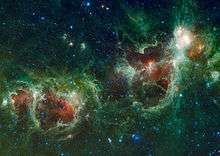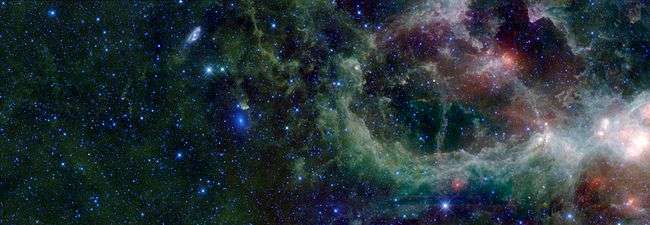Heart Nebula
| Emission nebula | |
|---|---|
| H II region | |
 The Heart Nebula | |
| Observation data: J2000.0 epoch | |
| Right ascension | 02h 33m 22s |
| Declination | +61° 26′ 36″ |
| Distance | 7,500 ly |
| Apparent magnitude (V) | 18.3 |
| Apparent dimensions (V) | 150' x 150' |
| Constellation | Cassiopeia |
| Physical characteristics | |
| Absolute magnitude (V) | 6.5 |
| Designations | IC1805, Sh2-190 |
The Heart Nebula, IC 1805, Sharpless 2-190, lies some 7500 light years away from Earth and is located in the Perseus Arm of the Galaxy in the constellation Cassiopeia. This is an emission nebula showing glowing ionized hydrogen gas and darker dust lanes.
The very brightest part of this nebula (the knot at the right) is separately classified as NGC 896, because it was the first part of this nebula to be discovered.
The nebula's intense red output and its configuration are driven by the radiation emanating from a small group of stars near the nebula's center. This open cluster of stars known as Melotte 15 contains a few bright stars nearly 50 times the mass of our Sun, and many more dim stars that are only a fraction of our Sun's mass.
Gallery
 Open Cluster Melotte 15 at the core of IC 1805.
Open Cluster Melotte 15 at the core of IC 1805.
 NGC 896 using 32 inch Schulman telescope on Mt. Lemmon, AZ. (orientation modified)
NGC 896 using 32 inch Schulman telescope on Mt. Lemmon, AZ. (orientation modified)

See also
References
External links
Coordinates: ![]() 02h 33m 00s, +61° 27′ 00″
02h 33m 00s, +61° 27′ 00″
| Wikimedia Commons has media related to IC 1805. |
- Heart Nebula at Atlas of the Universe
- NASA Astronomy Picture of the Day: Heart Nebula (14 February 2009)